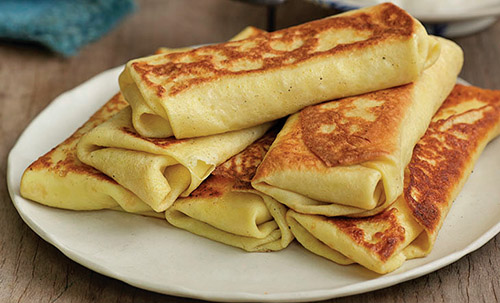
Are blintzes inherently Jewish?
Most scholars agree that “blintz” is a Yiddish term or at least is derived from a similar Yiddish term, “blintse.” For this reason alone, blintz is inherently Jewish because Yiddish itself is inherently Jewish. And how do we know that Yiddish is inherently Jewish? Well, for starters, it’s a language that includes terms such as milchig, fleishig and treif. Enough said.
By definition, a blintz is a thin pancake folded to form a casing that is then sautéed or baked. It is similar to a French crepe or Russian blin and it likely shares the latter’s etymology. In other words, blintz is to blin what boychik is to boy.
Blintzes usually are filled with cheese, fruit or potato and, in that vein, they follow a long line of stuffed Jewish edibles, including stuffed cabbage, stuffed peppers, knishes, kreplach, Moroccan cigars and bourekas. Jews also enjoy stuffed treats from other cuisines, including calzones, burritos and dumplings. Of course, Jews consume plenty of non-stuffed items but they are just not as much fun to eat. By analogy, would you rather celebrate your birthday with a plain bowl of candy or a piñata? Would you rather end a meal with a plain cookie or a fortune cookie?
Some scholars trace the first Jewish-made blintz back to the early 1900’s, whereas its relative, the pancake, traces all the way back to the Ancient Greeks. Apparently, it took over 2,000 years before some genius thought to roll up a pancake and—voila!—create a blintz. From now on, whenever there is an impactful new invention in the Jewish world, instead of saying that it’s the greatest thing “since sliced bread,” we should say it’s the greatest thing “since the rolled-up pancake,” i.e., the blintz. We could use this expression when some chacham finally invents, for example, disposable kippot, everlasting Havdalah candles or instant cholent.
One strange aspect of “blintzing” is that most people do not eat just a single blintz in any one sitting. Two blintzes is the universal minimum and it often is exceeded. You would be very hard-pressed to find a restaurant menu on the planet that allows a customer to order a single blintz. Even if a menu permitted solo blintz service, the average “blintzer” would still order no less than two blintzes. Ordering a single blintz would be almost as weird as ordering a single French fry.
Another strange aspect of “blintzing” is that despite the relatively wide variety of fillings, including both pareve and dairy, few if any blintz-makers offer meat-filled blintzes. The chances of finding a fleishig blintz are almost as slim as the chances of finding a Lubavitch tattoo artist.
It is difficult to gauge how many Jews even know how to make a blintz. While it does not seem like rocket science, it certainly is harder than boiling water. That said, if you can make a pancake, then you should be able to make a blintz, as long as you know how to roll. In this respect, the typical Torah-rolling gabbai might be the ideal blintz-maker just like the typical Hagbah-doer might be the ideal Olympic weightlifter.
Even though the blintz and pancake have many commonalities, no self-respecting nosher would ever mistake a blintz for a pancake. Blintzes, however, remain relatively popular and it would not be altogether shocking to see the opening of an IHOB, i.e., International House of Blintzes. (Yes, since Jerusalem already has Melech Hafalafel / King of the Falafel, then it also should have Prince of the Blintz.)
Ordinarily, the blintz-eating demographic tends to trend older, with bubbies and zaydes downing far more blintzes than the kinderlach, who often wince at the sight of a blintz. This does not mean that blintzes are subject to a minimum age limit. Any Jew, young or old, may eat a blintz just like any Jew may play Canasta.
Let’s not mince (or blintz) words: blintzes rarely appear in a fine-dining setting. If you are devouring rib-eye steak or rack of lamb, then you do not also have a blintz on your plate. Even a wedding or bar mitzvah spread will not normally feature blintzes. A blintz buffet is about as unlikely as a shakshuka smorgasbord. The blintz is for casual dining and arguably can be classified as a finger-food. While it is not crazy to eat blintzes with a fork and knife, they also can be hand-held like knishes. That said, if you find yourself eating a scoop of blintz-cream out of a blintz cone with blintz-y sprinkles, then you need to re-evaluate your life.
Final thought: To blintz or not to blintz, that is the question.
By Jon Kranz











